Letters from Lodi
An insightful and objective look at viticulture and winemaking from the Lodi
Appellation and the growers and vintners behind these crafts. Told from the
perspective of multi-award winning wine journalist, Randy Caparoso.
2022 update on Lodi's oldest vine growths (part 3)—the Clements Hills AVA
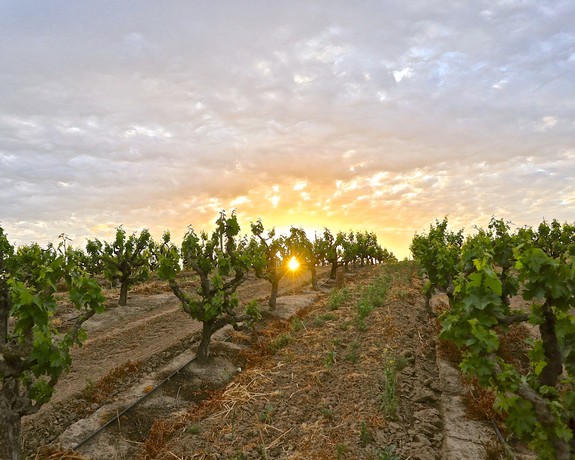
DeLuca Vineyard—Michael David Winery's own-rooted Zinfandel, originally planted in 1961, in rolling hills of Lodi's Clements Hills AVA.
Continued from our previous post: 2022 update on Lodi's oldest vine growths (part 2)—east side of the Mokelumne River AVA
Perhaps the most unique Zinfandels in all of California are grown along the south and north banks of the Mokelumne River as it winds its way through Lodi's Clements Hills appellation before the river hits its namesake appellation to the immediate west, the Mokelumne River AVA.
Most of the soils found in the Clements Hills AVA—located east of the City of Lodi in the vicinity of the census-designated communities of Lockeford and Clements—contrast significantly with that of Lodi's Mokelumne River AVA. Here, the Lodi topography transitions from flat sandy loams into rolling hills topping off at about 400 ft. elevation, dominated by shallow, visibly red (or yellowish-brick red) clay loams of volcanic origin, which are gravelly or cobbled, and less vigorous on the hilltops.
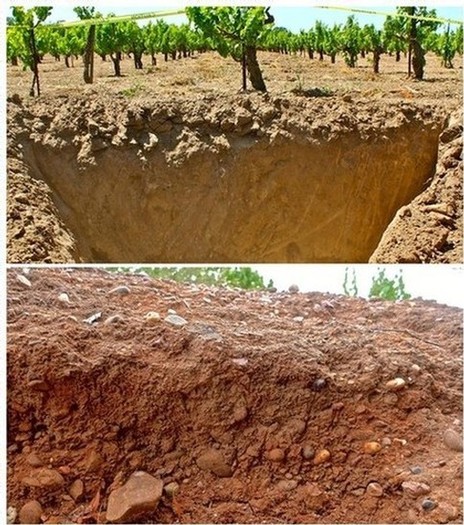
The deep Tokay series sandy loam defining Lodi's Mokelumne River AVA (top) contrasted with the shallower cobbled clay Redding series soil (bottom) of the Clements Hills AVA.
Alongside the river, however, there are a few small pockets of sandy loam soil similar to that of the Mokelumne River AVA. It is in these sandy soils that enterprising growers began planting Zinfandel during the 1920s to meet the growing market for grapes supplying home winemakers across the country during the Prohibition years.
While the Zinfandels grown in these riverside vineyards are similar to that of the east side of the Mokelumne River AVA in terms of red fruit fragrances, they are slightly different with respect to lower pH, higher acidity, and tannin content. That is to say: Clements Hills style Zinfandels tend to have the edgy acid/tannin structure similar to foothill style Zinfandels grown in Amador County just to the east, yet retain the floral, flower petal, tea, and cherry fruit spectrum of Mokelumne River-Lodi Zinfandels.
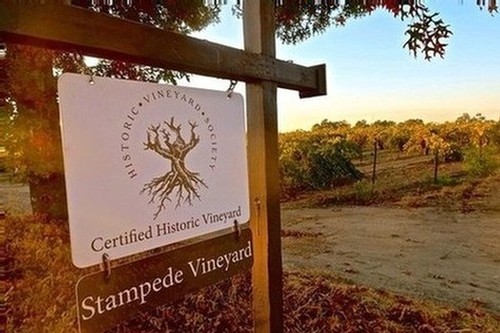
Lodi's Stampede Vineyard is a source of classic, fragrant, sturdily structured Clements Hills styles of Zinfandel.
Neither are these Zinfandels as soft and earthy as the classic Lodi style Zinfandels grown in the sandy soils surrounding the City of Lodi. They are, you can say, unique unto themselves, which makes them all the more worthy of any wine lover's attention.
Old vine growths in Lodi's Clements Hills AVA
Dogtown Vineyard, Zinfandel
Vineyard name: Dogtown Vineyard
Year planted: 1944
Size: 11.7 hectares
Variety(ies): Zinfandel
Wineries: Turley Wine Cellars
• This 29-acre vineyard consists of small, own-rooted, head-trained Zinfandel vines originally planted in 1944, and has been managed by Turley Wine Cellars since 1997 on a long-term lease.
• Although located on a sloping site in the Clements Hills AVA, Dogtown is close enough to (just north of) the Mokelumne River to retain a mix of fine and coarse sandy loam soils in the Cometa and Montpellier series. These soils are similar to the pulverized granite found in Lodi’s historic Mokelumne River vineyards, with pale brick-colored clay loam.
• This unique terroir produces a proven long-lived, consistently fine-grained, lush red fruit and tea-nuanced Lodi-style Zinfandel, with a firm acid/tannin structure recalling the higher hillside-grown Zinfandels of nearby Amador County, retaining a phenomenal sense of lightness even at alcohol levels as high as 16%.
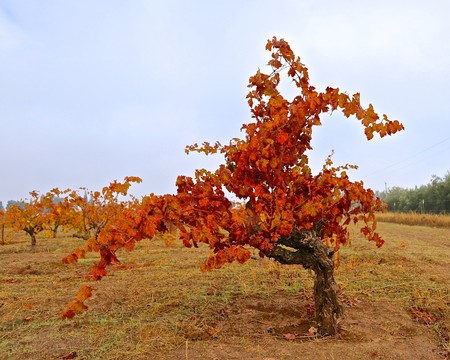
October colors of own-rooted Zinfandel in Clements Hills-Lodi's Dogtown Vineyard.
Stampede Vineyard, Zinfandel
Vineyard name: Stampede Vineyard
Year planted: 1920s and 1940s
Size: 8.9 hectares
Variety(ies): Zinfandel; Mission; Mourvèdre
Wineries: Maître de Chai; Fields Family Wines; Haarmeyer Wine Cellars; Sabelli-Frisch; Earth Signs (by Mountain Tides); Tank Garage Winery; RD Winery; Hibou Winery; Little Trouble Wine Co.; Christopher Cellars
• This 22-acre, Zinfandel-dominated growth was planted in the 1920s and 1940s by J.J. Zechmeister and C.H. Süss on a bluff that was once a southern embankment of the Mokelumne River, north of Highway 88 in Clements, adjacent to the Clements Buckaroos Rodeo Grounds. Soil types are primarily fine sandy loams in the Kingdon and Tokay series.
• The vines are primarily head-trained, own-rooted Zinfandel, with smatterings of Mission and Mourvèdre, planted in an unusual diamond-shaped pattern with 9- to 10-foot by 10-foot spacing.
• Wines are produced as distinctive single-vineyard Zinfandels by Fields Family Wines as well under Fields Family's Lodi Native label. These bottlings possess a notably firm acid/tannin edge similar to Sierra foothills-style Zinfandels while retaining a roundness as well as red fruit (cherry/raspberry) fragrances typifying many Lodi-grown Zinfandels.
• The vineyard is owned and farmed by Jeff and John Perlegos, and fruit has been going into vineyard-designate bottlings crafted by a host of small, artisanal wineries, including Maître de Chai, Haarmeyer Wine Cellars, Sabelli-Frisch, Earth Signs (by Mountain Tides), Tank Garage Winery, RD Winery, Hibou Winery, Little Trouble Wine Co., and Christopher Cellars.
• Registered by Historic Vineyard Society.
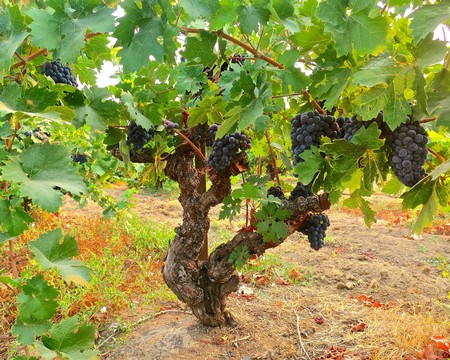
Small Zinfandel clusters are typical of the Clements Hills AVA in Lodi's Süss Vineyard.
Süss Vineyard, Zinfandel
Vineyard name: Süss Vineyard
Year planted: Late 1920s
Size: 6 hectares
Variety(ies): Zinfandel
Wineries: Bokisch Vineyards; Jeremy Wine Co.
• This 15-acre growth consists of own-rooted, head-trained, traditional goblet-shaped Zinfandel planted during the late 1920s by C.H. Süss, south of Highway 88 between Lockeford and Clements, just east of Disch Road.
• The distinctive quality of this vineyard is that it lies in an uneven swale of particularly fine-grained, almost talcum powder-like loamy sand.
• Bokisch Vineyards has farmed and bottled the fruit as a vineyard-designate wine under their Tizona label since 2015. Most recently (2021), Jeremy Wine Co. established a winery on the property and has begun producing Zinfandel from the vineyard
• Süss has established a modest track record for sturdy, medium-to-full-bodied Zinfandels with notably high natural acidity, silky fine texturing, and floral notes of cherry and plum underscored by wild scrub-nuanced spice.

Classic "gobelet" (i.e., head trained) Zinfandel in Clements Hills-Lodi's DeLuca Vineyard.
DeLuca Vineyard, Zinfandel
Vineyard name: DeLuca Vineyard
Year planted: 1961
Size: 65 hectares
Variety(ies): Zinfandel
Wineries: Michael David Winery; Macchia Wines
• This expansive 160-acre planting of own-rooted, uniformly sculpted goblet-trained Zinfandel vines was planted by Louis DeLuca in 1961, utilizing choice plant material from a nearby family vineyard.
• While located in Clements Hills and planted on rolling hillsides typical of the appellation, the site sits on the north bank of the Mokelumne River where the predominant soil is a white-ish sandy loam similar to that of the Mokelumne River AVA.
• For many years this vineyard was meticulously cultivated by LODI RULES for Sustainable Winegrowing by former owner/grower Dave Devine, supplying both small wineries (such as Macchia Wines) and large ones (Michael David Winery). By 2009, almost the entire vineyard was going to Michael David for their 7 Deadly Zins production.
• In 2017 the vineyard was purchased by the Phillips family, who now utilizes the fruit strictly for Michael David Winery bottlings—particularly for the winery's Freakshow Zinfandel program, but also small amounts going into a fragrant, low-key, finely balanced vineyard-designate wine (typical of east side Lodi Zinfandels) sold in the Michael David tasting room.

Massive trunk and fruit of Flame Tokay in Viola's Vineyard.
Viola's Vineyard, Zinfandel
Vineyard name: Viola's Vineyard
Year planted: 1948-1949
Size: 14.2 hectares
Variety(ies): Zinfandel; Flame Tokay
Wineries: Delicato Family Vineyards; E. & J. Gallo Winery
• While registered with the Historic Vineyard Society, this vineyard has not historically produced a vineyard-designate wine; rather, grapes go into blended red wines produced by big production wineries.
• The own-rooted Zinfandel, interplanted with a few Flame Tokay vines, was originally planted by John R. Wiederrich and is owned by Wiederrich's granddaughter Janet Klapstein (the vineyard is named after Klapstein's mother, Viola Klapstein).
• The vineyard site sits on the same sandy bluff on the south side of the Mokelumne River as other well-known Clements Hills AVA old vine plantings (notably, Stampede Vineyard and Süss Vineyard).
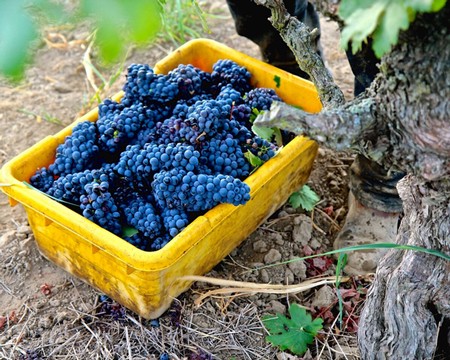
Clements Hills-Lodi Zinfandel harvest in Stampede Vineyard.